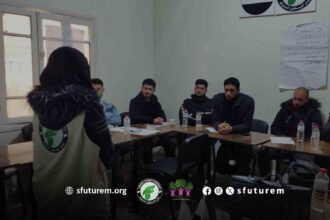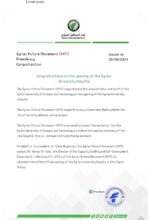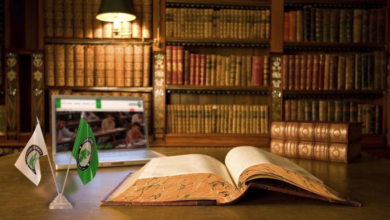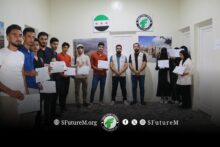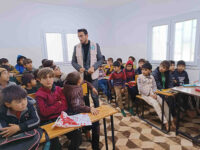“Economic Confederation in the Four Syrian Regions!”
Syrian Future Movement (SFM)
Political Office
Research No. (01-11-23)
Issued on 05-11-2023
Researcher: Jacqueline K. Al-Shami
Researcher in the Department of Research and Studies (SFM)
Introduction:
The global media deliberately overlooks the current Syrian situation in its present state, ignoring the Syrian reality that is divided into four areas, each of which is an unofficial confederation with a different political leadership.
In this article, we shine a light on the Syrian economic reality in its four regions, which confirms that Syria is completely divided, only awaiting an official declaration! Indeed, all the prerequisites for the existence of a confederal region are now available, topped by the economic reality that will impose a state of self-sufficiency and independence.
As we at the Economic Office of the Syrian Future Current open this file, we aim to highlight the political reality from an economic angle, which indicates structural differences that make merging into a new central government impossible.
The Economic Reality in Assad’s Regions:
The economy in the areas controlled by the Syrian regime faces significant challenges. The economic crisis in Syria has led to a deterioration of living conditions, where Syrians face severe living and service crises, including prolonged power outages and unprecedented increases in the prices of essential goods, along with a decline in the purchasing power of salaries in both the public and private sectors.
All this is related to poverty and its indicators! The poverty rate in areas under regime control reaches 98%, unemployment exceeds 70%, and the level of wages is around 35 dollars per month.
As for assessing the imbalance in the living standards of the Syrian citizen in Syria, it is difficult due to the lack of data! However, the gap is very wide between a small class of war beneficiaries and wealthy businessmen linked to the Syrian regime, and the impoverished majority. There are also geographic, ethnic, and sectarian disparities that we are not addressing here.
The reason for all this is that markets in areas under regime control are dominated by monopolistic practices, with competitiveness being almost nonexistent in light of some businessmen using their political and military influence to achieve economic gains.
Up until 2011, the state in Syria controlled all aspects of the economic life, but this control was further distorted during the recent period of conflict by the armed militias associated with the regime. Syria ranked 176 out of 190 countries in the Ease of Doing Business Index for the year 2019, according to the World Bank, scoring 42.0 points. This was amidst numerous obstacles such as permits, cross-border trade, and obtaining credit, concerns that were exacerbated by global inflation and the Russo-Ukrainian War.
The spread of corruption also increased the cost of doing business, while the damage from the conflict severely impacted several economic sectors, creating opportunities for smuggling and law breaches. In 2021, it was estimated that the amount of untaxed money in the regime-controlled areas was 3.2 trillion Syrian pounds, and 100 million dollars.
As a result of both direct and indirect pressures on Syrian businessmen, the majority emigrated from the country, especially after the depletion of their resources and capital by the Syrian regime and its militias. In 2020, more than 40,000 Syrian investors and traders emigrated.
Regarding the macroeconomy, the trade deficit as a percentage of the Gross Domestic Product (GDP) increased from 16.6% to 34.6% in 2021.
As for inflation, the Consumer Price Index continued to rise over the previous years, reaching 250% on an annual basis in 2020 and then declining to 97% in 2021.
Additionally, regime-controlled areas in Syria also witnessed a severe fuel crisis, leading to significant paralysis in transportation and the cessation of many events, industries, and businesses.
According to a report by the Arab Center for Research and Policy Studies, the economic crisis in Syria is due to several reasons, including international economic sanctions, the collapse of the exchange rate, and rising consumer prices. Furthermore, the Syrian regime relies on the concept of economic control and dominance over the means of production and rent-seeking, making Syrian traders, capital owners, and warlords invest in sectors with high financial returns that benefit the regime.
The Economic Reality in the Territories of the Salvation Government:
The Salvation Government controls the province of Idlib and its countryside and attempts to expand towards the areas of influence of the National Army at the crossings between them and the Syrian Democratic Forces (SDF), aiming to benefit from the revenue of these crossings. This was evidenced by recent actions of Hay’at Tahrir al-Sham when it solidified its control over the fuel market in the National Army’s areas of influence in the countryside of Aleppo through its arms, represented by “Ahrar Al-Olan” and other security and economic figures, after having monopolized the fuel sector in its areas of influence in Idlib province. The Salvation Government, which made substantial profits by selling fuel in Idlib at higher prices than in the National Army-controlled areas, is considered the executive government of the “Hay’at Tahrir al-Sham” faction. In the areas controlled by Hay’at Tahrir al-Sham, the economy is mainly managed through the faction and those close to it, where the Salvation Government seizes all economic projects. Moreover, Hay’at Tahrir al-Sham has controlled the Bab al-Hawa crossing since mid-2017, monopolizing the benefits from fees, in addition to the exclusive import of products and goods.
The Interim Government, over the past years, has agreed to establish many “massive” investment projects in various fields, including industrial, commercial, or service sectors. Additionally, it has created an economic formula based on multiple investments and monopolizing investments in its areas, encouraging capital owners by proposing any economic project under the condition of the Salvation Government’s participation in it.
At the end of 2021, official work began on the establishment of an industrial city in the Bab al-Hawa area belonging to Idlib province on the border with Turkey, making it the first industrial city in the territories under the control of the “Salvation Government.”
In the midst of Idlib city and its surroundings, several investment projects have emerged, such as multistory stores (malls) and commercial markets, replacing random markets. The Salvation Government facilitated the arrival of electricity to Idlib in May 2021, after several years of outage, by approving the work of the “Green Energy” company.
During this period, the territories of the Salvation Government are witnessing a construction boom in various fields, including different types of buildings, whether residential, commercial, service, investment, or industrial.
Investments serve as the most effective economic lever in supporting both macroeconomic and microeconomic indicators, which directly impacts the Salvation Government. The presence of genuine investments in the territories controlled by the Salvation Government can support it economically, which, in turn, will reflect in political backing.
After taking control of the Idlib area and its surroundings, “the Organization” aimed to empower the role of the “Salvation Government” that it formed in 2017 and to secure a local economy isolated from other regions in Syria. This was partly linked to institutions and ministries affiliated with the Salvation Government, or through what could be called the economic circle of Tahrir al-Sham. This network includes individuals and companies directly connected to the leader of the organization and its prominent leaders, or companies directly managed by them. Between 2018 and 2020, it began establishing commercial companies and institutions in Idlib and paved the way for them to monopolize the trade and import of Turkish goods from the Bab al-Hawa crossing in the northern countryside of Idlib. It also worked on institutionalizing the operation of the crossings with the Syrian regime and opposition factions.
The General Establishment for Cash Management and Consumer Protection, affiliated with the Salvation Government, has set up foundations to control the currency exchange and exchange market in Idlib. It required exchange offices and money transfer companies to license their offices and pay financial amounts under the name “commission”, which is placed in the bank allocated for the institution. The institution determines the amount based on the spread of the licensed company, which has made the exchange rate in Syria affected by the currency dealers in Idlib Province!
The nature of the economy in the territories of Hay’at Tahrir al-Sham, “Salvation Government,” can be considered similar to the economy in the areas controlled by the Syrian regime, i.e., through the authority’s intervention in the economy and its acquisition, which means complete dominance that feeds the political and military presence!
Hay’at Tahrir al-Sham’s project does not rely on revitalizing the liberated areas as much as it aims to achieve its own goals, as is clear in its decision to ban exports, which negatively affects the farmers in its controlled areas. Considering that the production is mostly agricultural, this decision reduces the marketing outlets available for production disposal. It also negatively reflects on the northern regions of Syria in general, as it leads to a shortage in agricultural and food supplies, creating separate economic sectors, and hinders any potential future economic growth.
The Economic Reality in the Areas of the Syrian Interim Government:
The Syrian opposition’s interim government, under direct Turkish guardianship, has an advantage over other Syrian regions as it is not covered by U.S. sanctions, thus allowing it to import and export. This makes investors more comfortable from this perspective. However, the region needs an official financial institution, hence increasing investment is lacking the establishment of a branch for a global or regional bank!
The Syrian Interim Government has announced an investment conference in Northern Syria, with the Ministry of Economy and its partners beginning preparations for the conference scheduled for December 20th and 21st.
According to the ministry and the organizing committee, the conference aims to economically develop the liberated areas and contribute to improving the standard of living and increasing employment opportunities. This will be through creating an attractive investment environment, assessing the reality of investment in Northern Syria and identifying its requirements, establishing business incubators to develop small projects and stimulate young people’s initiatives in entrepreneurship, reaching strategic partnerships at both the domestic and international levels in the investment sector, in addition to developing an investment map from the perspective of sustainable development.
As for industrial investment in Northern Syria, it is significantly active with a rising number of Syrian and foreign investors, and the establishment of many investment, industrial, and craft projects, especially after the creation of industrial cities (in Azaz, Al-Bab, Al-Rai, and Jarablus) which provide many services to local communities, craftsmen, and workers.
The Economic Reality in the Areas Controlled by the Syrian Democratic Forces (SDF):
The economic situation in the areas controlled by the Syrian Democratic Forces is based on an open market policy and the non-intervention of the SDF in the economy directly. This, coupled with the semi-official blockade by Iraq, Turkey, Syria, and opposition areas and the state of wartime escalation, has negatively impacted the economy. As a result, economic indicators are not good, with poverty levels exceeding 90%, and resources are scarce due to weak imports. Therefore, the SDF relies on two main pillars:
The first pillar is the American and Gulf support, which includes the entry of aid and funds that are mostly invested in security and military issues. Consequently, the SDF’s economy is tied to militarization, which in turn supports other resources.
The second pillar is oil, which is a major source of income. The production of oil, exceeding 100,000 barrels per day, is largely sold to the Syrian regime, and a small portion to the opposition, due to the Turkish and Iraqi blockade on the SDF. Hence, the SDF is striving to control and direct spending within plans that regulate and dominate the market, thus making the economy dependent on their military presence in the region.
Conclusion:
Through this brief examination, it is clear that despite the overall economic deterioration in Syria, there exists a form of economic independence for each region. This independence will be further established over time, which will enable each political, and possibly military, party to expand its popular and public base. This may lead to an increasingly entrenched division within Syria, a reality that Syrians are living with and adapting to—especially the new generation that will grow up with this situation for years, perhaps decades. This division, which we in the Syrian Future Movement believe will persist and expand in the absence of a comprehensive political solution, is undeclared.
Hence, the practical solution that the Syrian Future Movement calls the “Grandmother of Syria” solution, akin to East Germany, involves directing political plans and projects towards this model, considering it as a first step towards implementing UN Resolution 2254. This resolution calls for the unification of the areas of influence of the three governments without the Syrian regime’s government (the Interim Government, the Autonomous Administration, the Salvation Government).
Therefore, at the Economic Office of the Syrian Future Movement, we believe that the solution should begin from an economic perspective, by establishing investments and projects that connect these three regions, serving as a cornerstone for establishing genuine and sustainable political relationships.
Ammar Al-Amouri
Researcher at the Scientific Office
Department of Research and Studies
Syrian Future Movement
المراجع
بعد 11 عاما على انطلاق الثورة.. هل انتصر النظام السوري؟ وعلى من؟ | أخبار سياسة | الجزيرة نت (aljazeera.net)
ما الواقع الاقتصادي لمناطق سيطرة النظام؟ – (trendsstudies.com)
الأزمة الاقتصادية في سورية: أسبابها وتداعياتها واتجاهاتها (dohainstitute.org)
الاقتصاد السوري: بين العقوبات الغربية وفشل النظام في إدارة الأزمة (dohainstitute.org)
هيئة تحرير الشام تتحكم بسوق المحروقات في مناطق سيطرة الجيش الوطني (syria.tv)
هيئة تحرير الشام – Sawab Center
مرصد الاقتصاد السوري، شتاء 2022 / 2023 (albankaldawli.org)
محاسيب الجولاني في الشمال السوري الجمهورية. نت (aljumhuriya.net)
إدلب.. الاستثمار تحت عباءة “الإنقاذ” – عنب بلدي (enabbaladi.net)
الحكومة السورية المؤقتة تحضر لأول مؤتمر استثمار في مناطق المعارضة (alaraby.co.uk)
اقتصاد الشمال السوري.. تحدٍّ جاد أمام مشروع “المنطقة الآمنة” • نون بوست (noonpost.com)
استهداف الموارد الاقتصادية لـ “قسد” بين الهدف العسكري والاستراتيجي – يحيى السيد عمر (yahyaomar.com)

